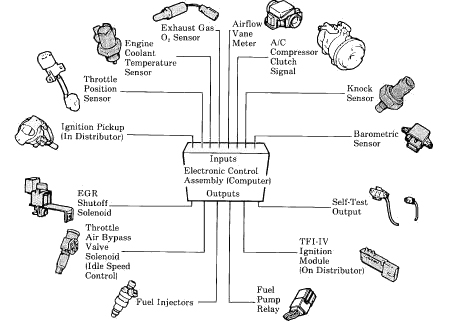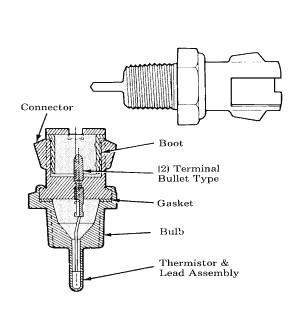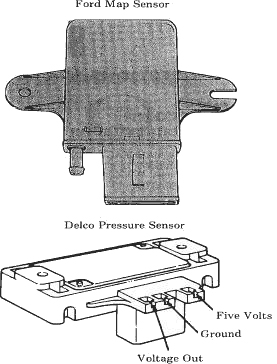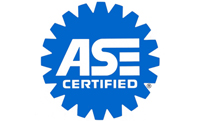Sensor Map
Sensor 02 Sensor Airflow Sensor TPS Knock Sensor Idle
solenoid controll coolant temp sensor
Which engine sensors are the most important

All sensors are important. The computer is the brains of a
computerized engine control system and sensors are its link
to what's happening under the hood.
Some sensors have more influence on engine performance than
others. These include the coolant temperature sensor, oxygen
sensor, throttle position sensor, and manifold absolute
pressure sensor.
The coolant sensor is often called the master sensor because
the computer uses its input to regulate many other
functions, including:
Activating and deactivating the Early Fuel Evaporation (EFE)
system such as the electric heating grid under carburetor or
the thermactor air system.
Open/closed loop feedback control of the air/fuel mixture.
The system won't go into closed loop until the engine is
warm.
Start up fuel enrichment on fuel-injected engines, which the
computer varies according to whether the engine is warm or
cold.
Spark advance and retard. Spark advance is often limited
until the engine reaches normal operating temperature.
EGR flow, which is blocked while the engine is cold to
improve driveability.
Canister purge, which does not occur until the engine is
warm.
Throttle kicker or idle speed.
Transmission torque converter clutch lockup.

The coolant sensor is usually located on the head or intake
manifold where it screws into the water jacket. Sensors come
in two basic varieties: variable resistor sensors called
thermistors because their electrical resistance changes with
temperature, and on/off switches, which work like a
conventional temperature sending unit or electric cooling
fan thermostat by closing or opening at a preset
temperature.
Variable resistor coolant sensors provide the computer with
a more accurate indication of actual engine temperature than
a simple temperature switch. The computer feeds the sensor a
fixed reference voltage of about five volts when the key is
on.
The resistance in the sensor is high when cold and drops
about 300 ohms for every degree Fahrenheit as the sensor
warms up. This alters the return voltage signal back to the
computer which the computer then reads to determine engine
temperature.
The switch-type sensor may be designed to remain closed
within a certain temperature range, or to open only when the
engine is warm. Switch-type coolant sensors can be found on
GM "T" car minimum function systems, Ford MCU, and Chrysler
Lean Burn systems.
Because of the coolant sensor's central role in triggering
many engine functions, a faulty sensor (or sensor circuit)
can cause a variety of cold performance problems. The most
common symptom is failure of the system to go into closed
loop once the engine is warm. Other symptoms include poor
cold idle, stalling, cold hesitation or stumble, and/or poor
fuel mileage.
The oxygen sensor (O2) measures how much unburned oxygen is
in the exhaust. The computer uses this as an indication of
how rich or lean the fuel mixture is so adjustments can be
made to keep it properly balanced.
A problem with the O2 sensor will prevent the computer from
keeping the fuel mixture balanced under changing driving
conditions, allowing the mixture to run rich or lean.
The throttle position sensor (TPS) is used with feedback
carburetion and electronic fuel injection (EFI) to inform
the computer about the rate of throttle opening and relative
throttle position. A separate idle switch and/or wide open
throttle (WOT) switch may also be used to signal the
computer when these throttle positions exist.
The throttle position sensor may be mounted externally on
the throttle shaft (the case on most fuel injection throttle
bodies), or internally in the carburetor (as in Rochester
Varajet, Dualjet and Quadrajet).
The TPS is essentially a variable resistor that changes
resistance as the throttle opens. It is the electronic
equivalent of a mechanical accelerator pump. By signaling
the computer when the throttle opens, the computer enriches
the fuel mixture to maintain proper air/fuel ratio.
Initial TPS setting is critical because the voltage signal
the computer receives tells it the exact position of the
throttle. Initial adjustment must be set as close as
possible to factory specs. Most specs are given to the
nearest hundredth of a volt.
The classic symptom of a defective or misadjusted TPS is
hesitation or stumble during acceleration. The fuel mixture
leans out because the computer doesn't receive the right
signal telling it to add fuel as the throttle opens. The
oxygen sensor feedback circuit will eventually provide the
necessary information, but not quickly enough to prevent the
engine from stumbling.
When the sensor is replaced, it must be adjusted to the
specified reference voltage. The TPS on most remanufactured
carburetors is preset at the factory to an average setting
for the majority of applications the carburetor fits. Even
so, the TPS should be reset to the specific application upon
which it is installed.

MAP sensor function is to sense air pressure or vacuum in
the intake manifold. The computer uses this input as an
indication of engine load when adjusting air/fuel mixture
and spark timing. Computerized engine control systems that
do not use a MAP sensor rely on throttle position and air
sensor input to determine engine load.
Under low-load, high-vacuum conditions, the computer leans
the fuel mixture and advances spark timing for better fuel
economy. Under high-load, low-vacuum conditions (turbo
boost, for example), the computer enriches the fuel mixture
and retards timing to prevent detonation.
The MAP sensor serves as the electronic equivalent of both a
distributor vacuum advance diaphragm and a carburetor power
valve.
The MAP sensor reads vacuum and pressure through a hose
connected to the intake manifold. A pressure sensitive
ceramic or silicon element and electronic circuit in the
sensor generates a voltage signal that changes in direct
proportion to pressure.
MAP sensors should not be confused with VAC (Vacuum)
sensors, DPS (Differential Pressure sensors), or BARO or BP
(Barometric Pressure) sensors. A vacuum sensor (same as a
differential pressure sensor) reads the difference between
manifold vacuum and atmospheric pressure (the difference in
air pressure above and below the throttle plate). A VAC
sensor is sometimes used instead of a MAP sensor to sense
engine load.
A MAP sensor measures manifold air pressure against a
precalibrated absolute (reference) pressure. What's the
difference? A vacuum sensor only reads the difference in
pressure, not absolute pressure, so it doesn't take into
account changes in barometric (atmospheric) pressure.
A separate BARO sensor is usually needed with a vacuum
sensor to compensate for changes in altitude and barometric
pressure. Some early Ford EEC-III and EEC-IV systems have a
combination barometric pressure/MAP sensor called a BMAP
sensor, combining both functions.
Anything interfering with accurate sensor input can upset
both fuel mixture and ignition timing. Problems with the MAP
sensor itself, grounds or opens in the sensor wiring
circuit, and/or vacuum leaks in the intake manifold.
Typical driveability symptoms include detonation due to too
much spark advance and a lean fuel ratio, and loss of power
and/or fuel economy due to retarded timing and an
excessively rich fuel ratio.
A vacuum leak can cause a MAP sensor to indicate low
manifold vacuum, causing the computer to think the engine is
under more load than it really is. Consequently, timing is
retarded and the fuel mixture is enriched.
OneStop Auto Shop
Call Today for
all of your Auto Repairs
and Maintenance
in Hollywood, Ca.!
(323) 227-9999
|

























